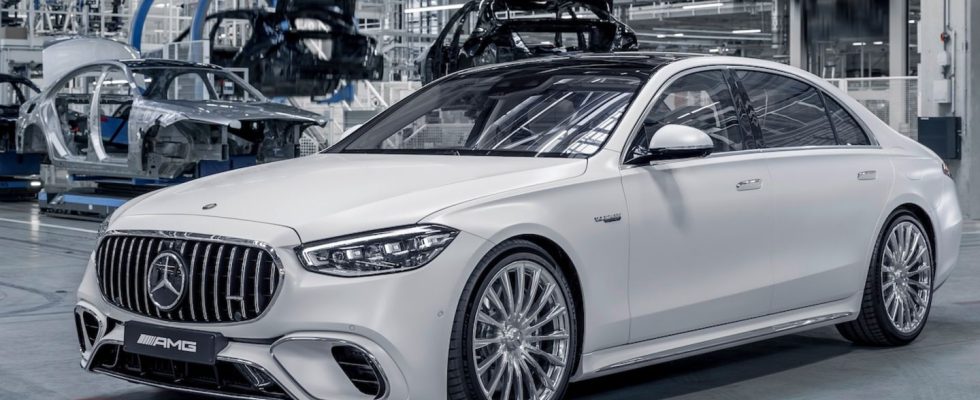Why is the Swabians’ flagship factory in Sindelfingen called Factory 56? You’re hardly used to such anglicisms even in production in Tuscaloosa / Alabama, because here too, German or, better yet, Swabian is often spoken at crucial points. But as important as the SUV factory in the southern United States has become, the best horse in the stable remains the 220,000 square meter Factory 56; a work that has hardly ever existed before, not only at Mercedes.
It’s quiet, incredibly clean and this high standard fits perfectly with the models manufactured there, because this is where the best of the best is created with the S-Class and the EQS. In addition, the gigantic hall is illuminated by bright LED light and even window hatches in the roof for natural lighting, which should also have a positive effect on the mood of the workers. What was Mercedes’ slogan once called? “The best or nothing” – pronounced in a decidedly Swabian manner and rather laughed at than perceived as a successful marketing slogan. This definitely applies to this production, in which 730 million euros were invested. In contrast to the previous production of the Mercedes S-Class, Factory 56, with its over 1,500 workers in two shifts, brings efficiency gains of around 25 percent.
It’s not just the lunch break that makes the workers on the assembly line at the Sindelfingen plant seem more relaxed than ever. The speed of the S-Class and EQS production line seems to be manageably fast and the modern production methods have implemented the individual work stations in such a way that hard physical times are a thing of the past. Among other things, the bodies on overhead rotary conveyors turn slightly towards the conveyor belt worker – to make their work as ergonomically easier as possible. The lunchtime snack comes to the respective work station via a silent delivery service and there are blue sofas where you can take a break between work.
Mercedes-Benz produces variably – and has to
But if you take a closer look at the production lines in the Swabians’ flagship factory and stroll up and down the aisle, you will also notice that hardly any electric Mercedes EQS is manufactured here. The Factory 56 is designed to be so variable that it can flexibly produce anything according to customer demand. The Mercedes S-Class as a combustion engine with diesel or gasoline engine, as a particularly elegant luxury Maybach, as an efficient hybrid or as a heavily armored S-Guard.
And then there is the electric Mercedes EQS, whose international demand is significantly lower than anyone would have ever expected. The rounded design is an issue because, although it is innovative, it does not look image-rich enough for the luxury sedan segment. The upcoming facelift with slight optical changes, especially to the front mask, will hardly change this. The EQS was supposed to become the electric S-Class – that failed. Even if high-ranking developers of the star brand repeatedly pointed out long before the start of sales that neither its rounded aero design nor the product substance would be sufficient, the Mercedes EQS should become the electric S-Class.
It’s good that production in Sindelfingen is so variable that you can vary the quantities accordingly, and so S-Classes with a wide range of wheelbases are primarily produced on the 56 series. A digital ecosystem called “MO 360” forms the basis for this flexible production and is intended to ensure that daily work on the production line is as pleasant as possible. Two “Tec Lines” at the start of the interior installation are intended to largely avoid fixed points during assembly. This means that conversion work that becomes necessary, for example due to the integration of any new models, can be implemented more easily in the rest of production. In these Tec Lines, driverless transport vehicles replace the classic assembly line, enabling a smooth change from flow to cycle operation. A total of over 400 such driverless transporters are in use at Factory 56. Machines and systems are networked with each other via a digital infrastructure via WLAN and 5G mobile networks.
The work dances at two weddings
In contrast to other production processes, the flexible production model also means that electric versions are manufactured in the same way as combustion engines, which is a challenge especially for the so-called wedding, the fusion of the floor assembly, drive and body. Once again, Mercedes no longer calls this a wedding, but rather a “Fullflex Marriage”, in which the body is connected to the drive. This technology association consists of several modular stations in Factory 56. The individual modules can be replaced within a weekend if requirements change, thereby avoiding lengthy production interruptions. “The future of our global Mercedes-Benz production network begins with the production of the EQS in Factory 56: This future is CO₂-neutral, sustainable, fully digitalized, networked and highly flexible,” says Mercedes Production Board member Jörg Burzer.
Of course, the new production is greener than ever. In contrast to other factories, Factory 56 is already CO2-neutral and has a significantly reduced energy requirement compared to other assembly halls. This is made possible, among other things, by an innovative energy concept. On the roof (40 percent green) of the production facility there is, among other things, a photovoltaic system that supplies the hall with self-generated electricity. This covers at least a third of the electricity requirement every year. Any excess electricity flows into a direct current network, which improves the energy efficiency of the hall, and into stationary energy storage based on old vehicle batteries. With a total capacity of 1,400 kWh, it is used to temporarily store excess solar power from the photovoltaic system.

